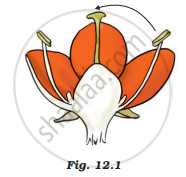Advertisements
Advertisements
प्रश्न
Why does self-pollination not lead to seed formation in self-incompatible species?
उत्तर
Self-incompatibility is a gene-physiological event. A single gene, known as the S-gene, regulates incompatibility reactions and contains many alleles. Pollen grains that have the S-allele, which is shared by any of the two alleles found in pistil cells, will not function on that pistil. However, any pollen grain that does not share any S alleles with the pistil of that plant will be functional on the pistil. Self pollens are unable to fertilise the egg, resulting in the formation of an embryo, hence seeds do not form in incompatible species.
APPEARS IN
संबंधित प्रश्न
A flower of tomato plant following the process of sexual reproduction produces 200 viable seeds.
Answer the following questions giving reasons :
(a) What would have been the minimum number of ovules present in pre-pollinated pistil ?
(b) How many microscope mother cells would minimally be required to produce requisite number of pollen grains ?
(c) How many pollen grains must have minimally pollinated the carple ?
(d) How many male gametes would have used to produce these 200 viable seeds ?
(e) How many megaspore mother cells were required in this process ?
Make a list of any three outbreeding devices that flowering plants have developed and explain how they help to encourage cross-pollination.
Can cross-pollination occur in cleistogamous flowers? Give reason for your answer.
What is bagging technique?
Complete the following chart and rewrite.
| Sr.No. | Agencies | type of pollination |
| 1 | Water | .................... |
| 2 | ........................... | Entomophily |
| 3 | Bat | .................... |
| 4 | ....................... | Ornithophily |
(Or)
Explain outbreeding devices in angiospermic plants.
Select and write the most appropriate answer from the given alternatives for the following subquestion:
A versatile anther is an adaptation for _______ type of pollination.
Mention any two contrivances in flowers which favour cross-pollination.
Describe pollination. How many types of pollinations are found?
Write different modes of pollination in detail with suitable examples.
For which of the following attractants and rewards are required?
Wind pollination is common in ______.
Pollination occurs in ______.
Chief pollinators of agricultural crops are ______.
Triple fusion in Capsella bursa pastoris is fusion of male gamete with ______.
A botanist studying Viola (common pansy) noticed that one of the two flower types withered and developed no further due to some unfavorable condition, but the other flower type on the same plant survived and it resulted in an assured seed set. Which of the following will be correct?
Which type of pollination does Figure 12.1 indicate?

What are the major abiotic factors that influence habitat?
Name the following:
Aquatic plants which are anemophilous.
Complete the following table:
| Sr. | Type of pollination | Agent | Kind of flower | Examples |
| (i) | ______ | Wind | ______ | Maize |
| (ii) | Chiropterophily | ______ | Dull colour, with strong fragrance, abundant nectar | Adansonia |
| (iii) | Entamophily | Insects | ______ | Rose/Jasmine |
| (iv) | Ornithophily | ______ | Brightly coloured, large and showy. They secrete profuse, dilute n ectar | ______ |
